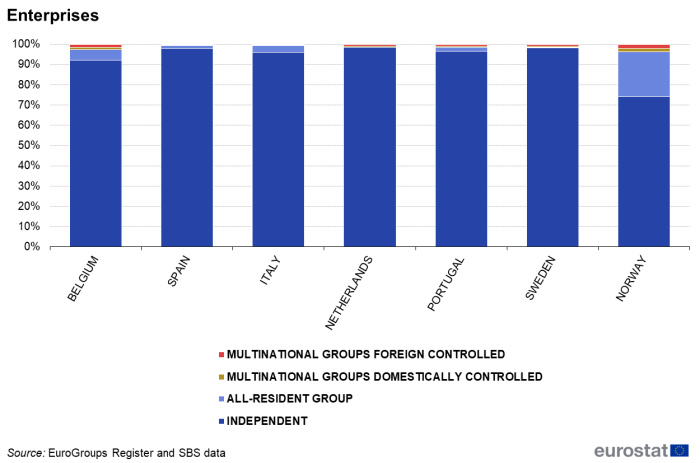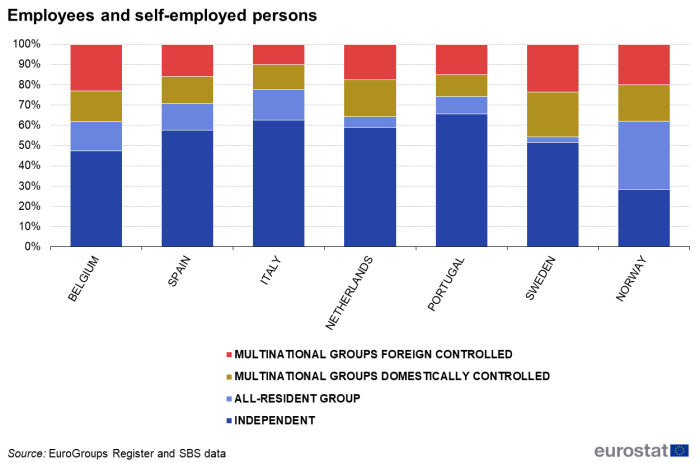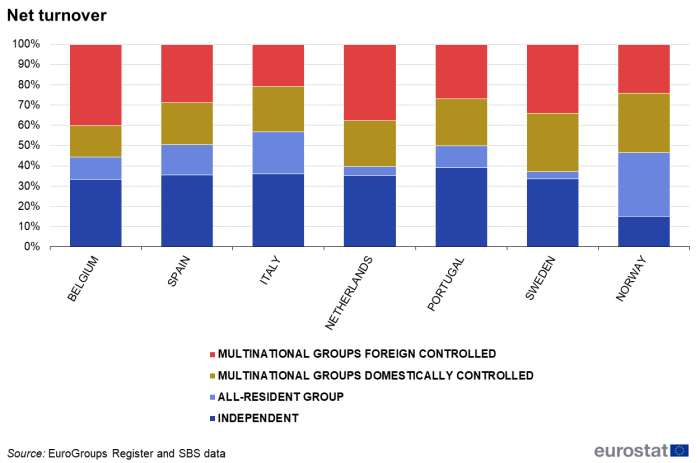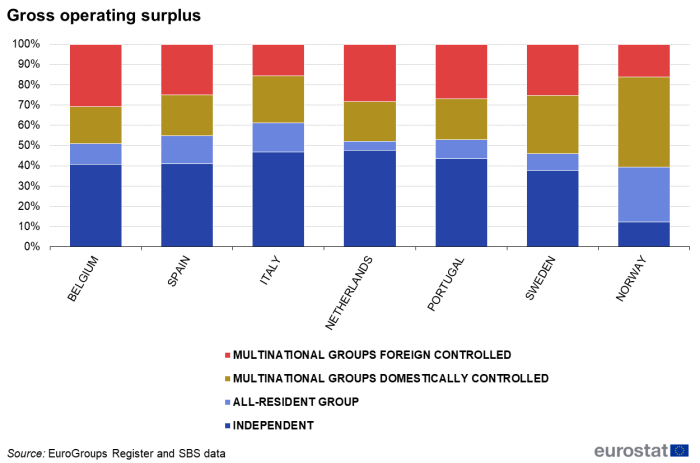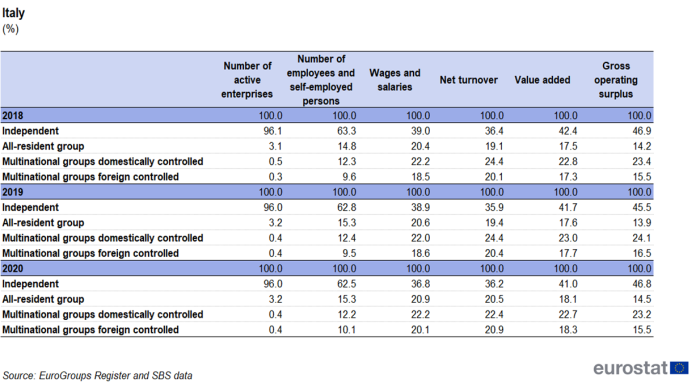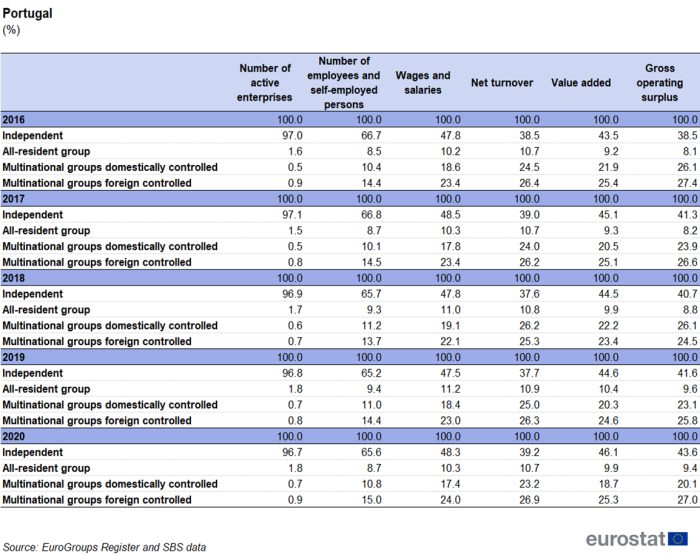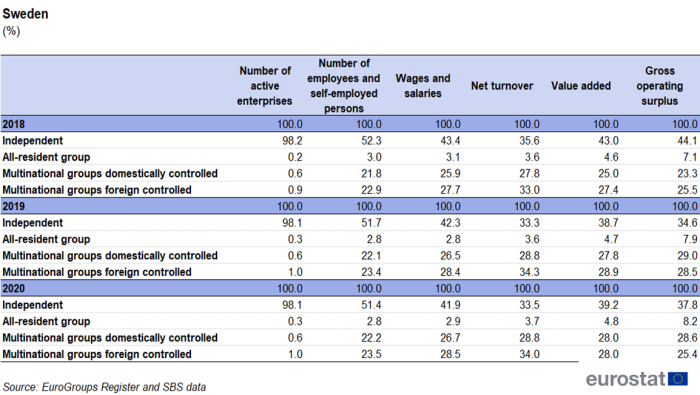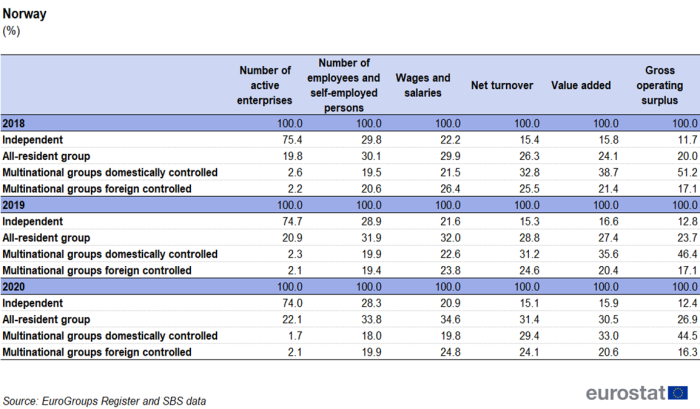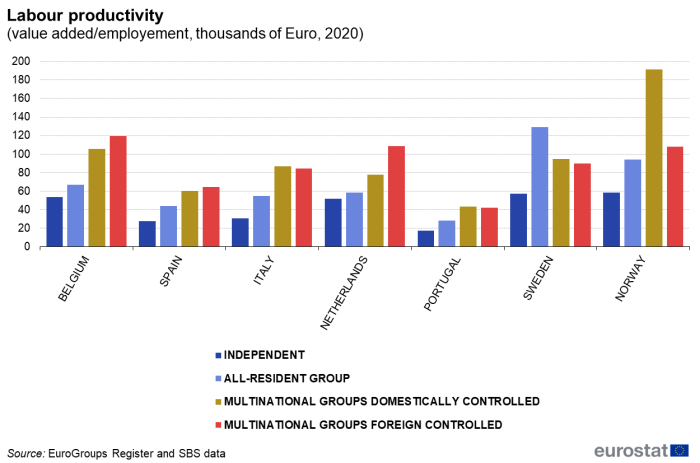Economic indicators of enterprises belonging to multinational enterprise groups
Data extracted in October 2023
Planned article update: December 2024
Highlights
This article has been drafted as a result of a micro data linking (MDL) exercise between EuroGroups Register (EGR) and Structural Business Statistics. Multinational enterprise (MNE) groups play a major role in the EU economy. They contribute substantially to the production of goods and services, employment and investment in all EU countries. This article presents the first findings of a voluntary exercise of seven countries (Belgium, Spain, Italy, the Netherlands, Portugal, Sweden, Norway) that used micro data linking (MDL) to derive new breakdowns of selected indicators of structural business statistics (SBS) according to information on multinational enterprises (MNEs) available from the EuroGroups Register (EGR).
Full article
Presence and economic relevance of enterprises belonging to MNE Groups
One of the key aspects of this MDL exercise was to provide the data on the most significant SBS variables broken down by control over the enterprises using the information available in the EuroGroups Register. Furthermore, this analysis enables us to compare the economic indicators between independent enterprises and those enterprises that belong to a multinational enterprise group.
In the seven participating countries, the share of independent national enterprises reached 96 % out of all enterprises. However, the remaining 4 % of enterprises that belonged to a national or a multinational enterprise group had a considerable contribution to the total employment as they employed more than 42 % of the persons employed. In addition, dependent enterprises had shares of more than 62 % as regards wages and salaries, and almost 66 % of the net turnover, and created more than 61 % of the total value added and almost 59 % of the gross operating surplus. This is a pattern that can be observed across all seven countries.
Focussing on the enterprises that belong to an MNE group, even though they represented only 1 % of the total number of enterprises in the seven countries, they accounted for almost 30 % of the total employment, 48 % of the total wages and salaries, 52 % of the net turnover, 47 % of the value added and 46 % of the gross operating surplus. This data provides evidence of the significant economic impact of MNE groups on the national economies.
At country level, the share of independent enterprises was highest in the Netherlands, Sweden and Spain (around 98 %), followed by Portugal (97 %) and Italy (96 %). In terms of employment, independent enterprises in Portugal and Italy had the largest shares (66 % and 62 % respectively), while the lowest shares (47 % and 28 % respectively) could be observed for Belgium and Norway . Similar rankings emerged for the other selected indicators on wages and salaries, net turnover, value added, and gross operating surplus.
Selected economic indicators of enterprises by country and group status, 2020
In Tables 1-7 below, the detailed overview of each country’s data can be found. Each of the seven countries provided the requested breakdown for a certain number of reference years. Countries that asked for financial support from the European Commission were requested to send the data for at least 3 consecutive reference years between 2016 and 2020. Those countries that ran the exercise on a voluntary basis could provide data for a smaller number of reference years.
All countries sent the data for the reference years 2019 and 2020
For Belgium, the voluntary data collection covers 3 reference years: from 2018 to 2020. The share of independent enterprises remained stable over this time. For the reference year 2020, it can be observed that around 8 % of the total number of enterprises belonged to an enterprise group, meaning they were dependant enterprises, while 92 % were independent enterprises, not controlled by any other domestic or foreign legal unit. The dependant enterprises in Belgium represented more than 50 % of the total employment, creating almost 70 % of the value added.
Spain provided data for the reference years 2019 and 2020. The share of independent enterprises in the total number of enterprises in 2020 reached almost 98 %. The dependent enterprises (part of an all-resident enterprise group or a MNE group) represented 42 % in terms of employment, created 60 % of the value added, with the share of wages and salaries also reaching 60 % of the total.
The share of the dependent enterprises in the Italian economy was similar to that in other countries, representing around 4 % of the total population of enterprises in 2020. However, this 4 % of enterprises generated 64 % of the turnover of the Italian economy and was responsible for 59 % of the value added. The share of the enterprises belonging to the MNE groups (domestically or foreign-controlled) in the total population was very stable over the time – they represented 0.8 % of the total number of enterprises. In terms of employment, their presence was quite significant as they represented around 22 % of the total employment.
For the Netherlands, data for 4 reference years are available: 2017-2020. The share of the enterprises belonging to MNE groups in the total population enterprises did not change over the years and counted for around 1.5 %. The enterprises being a part of an MNE Group (domestically or foreign-controlled) represented around 36 % of the employment in 2020, contributed with 60 % to the net turnover and created around 50 % of the value added. In the same year the independent enterprises (98 % of the total number of enterprises) recorded a share of 35 % in terms of turnover and around 46 % in terms of value added.
For Portugal, data for 5 reference years are available: 2016-2020. The share of independent enterprises accounted for 97 % and remained stable over the years. In 2020 the independent enterprises accounted for around 66 % in terms of employment. The share of enterprises belonging to MNE groups was around 1.5 %, generating around 44 % of the value added and creating 50 % of the net turnover.
For Sweden, data for three reference years, 2018-2020, were provided. The share of independent enterprises remained also very high in Sweden– more than 98 %. In 2020 the independent enterprises generated around 39 % of the total value added of the national economy. While only 1.6 % of the enterprises’ population belonged to an MNE group, they employed almost 45 % of the total persons employed and contributed with around 56 % to the value added.
For Norway, data for three consecutive reference years are available: 2018-2020. Compared with other countries, it can be observed that the share of independent enterprises in the total population was much smaller – they represented 74 % in 2020. In terms of value added, the independent enterprises created around 16 % of the total value added. The share of enterprises belonging to MNE groups recorded a slight decrease between 2018 and 2020 – in 2018, the share of enterprises belonging to MNE groups counted for 4.8 % of the total population of enterprises in 2018, while it was only 3.8 % in 2020.
Performance indicators of enterprises by group status, 2020
Similarly for all countries, for the reference year 2020 the average size of an enterprise in terms of employment was as follows: independent enterprises employed on average 2.6 persons, enterprises that were a part of all-resident (domestic groups) recorded around 20 persons employed, while the enterprises belonging to domestically-controlled MNE groups counted on average 118 persons and enterprises belonging to the foreign-controlled MNE groups employed similarly 100 persons.
The economic variables such as the value added, wages and salaries, and the gross operating surplus are highly correlated for the enterprises belonging to MNE groups. In terms of average wages and salaries, the independent enterprises counted on average €15 000 per employee per year across 7 countries (ranging from €9 000 in Portugal to €31 000 in Norway). The level is significantly higher when looking at wages and salaries paid by the enterprises belonging to enterprise groups. In enterprises belonging to the all-resident (national) enterprise groups, the wages and salaries reached on average more than €26 000 per employee per year (€15 000 in Portugal and €43 000 in Norway); while the average salaries and wages paid by enterprises belonging to domestically-controlled MNE groups reached €36 000 per year (€20 000 in Portugal and €46 000 in Norway). The highest level of average wages and salaries was recorded for enterprises being part of a foreign-controlled MNE group with €39 000 per year (€20 000 in Portugal and around €52 000 in Belgium and Norway). For example, on average, in Belgium and Italy, the level of wages and salaries in an enterprise belonging to a national enterprise group was twice as high as in an independent enterprise. Interestingly, average wages and salaries recorded for enterprises belonging to an MNE group (domestically and foreign-controlled) were more than 3 times higher than in an independent enterprise.
In terms of labour productivity, which is calculated as the ratio of value added and the number of persons employed, this performance indicator is highly correlated to the group status of the enterprises. Independent enterprises scored lower figures compared with the dependent enterprises, in particular those being part of a foreign-controlled MNE group. Interestingly, the behaviour is somewhat different for Sweden (where labour productivity is highest for enterprises belonging to all-resident groups) and Norway (where labour productivity is significantly higher for enterprises belonging to domestically controlled multinational groups).
On average, the labour productivity ranged from €35 000 per person employed for independent enterprises compared with €57 000 in domestic enterprise groups and to €84 000 in MNE groups (domestically and foreign-controlled).
Selected economic indicators of enterprises by NACE sections and group status, 2020
The presence and economic behaviour of enterprises according to their group status was not uniform across industries. In terms of employment, the share of independent enterprises was higher in some sectors, such as repairing (Section S) (83 %), real estate (Section L) (83 %), accommodation and food services (Section I) (79 %) as well as construction (Section F) (76 %).
Looking at sectors where the enterprises belonging to the MNE groups are often present, it can be observed that mining and quarrying (Section B) (63 %), electricity/gas/steam/air conditioning (Section D) (60 %) and information and communication (Section J) (49 %) seemed to be the relevant sectors in terms of employment.
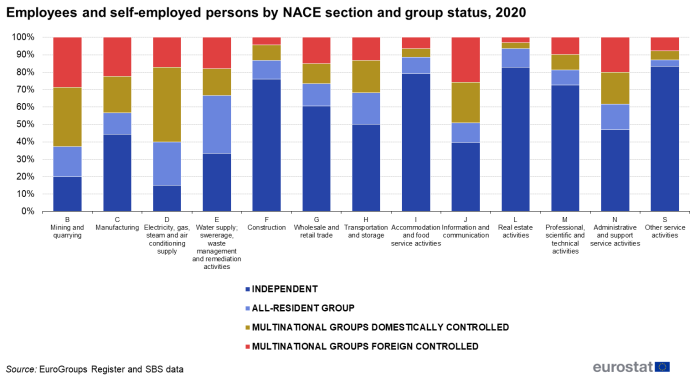
Source: EuroGroups Register and SBS data
Link to Nace Rev.2 classification
Wages and salaries paid by the enterprises belonging to the MNE groups (both domestically and foreign-controlled) recorded highest amount within activities like electricity/gas/steam/air conditioning (Section D) (74 %), mining and quarrying (Section B) (69 %), information and communication (Section J) (65 %) or manufacturing (Section C) (60 %).
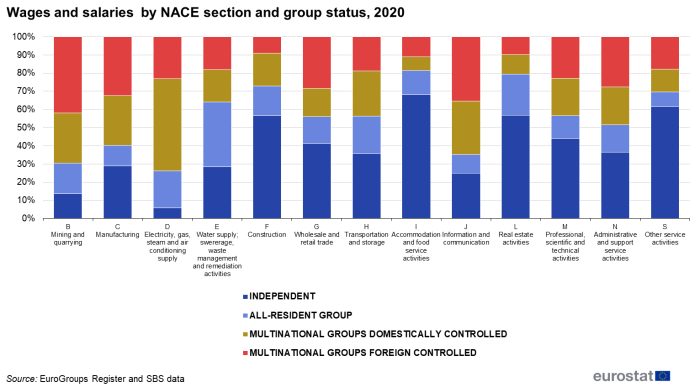
Source: EuroGroups Register and SBS data
Link to Nace Rev.2 classification
The figures for the value added follow a similar pattern to employment as the highest share of the valued added created by enterprises belonging to an MNE group (domestically and foreign-controlled) could be recorded for the same activities: mining and quarrying (Section B) (85 %), electricity/gas/steam/air conditioning (Section D) (75 %), information and communication (Section J) (67 %).
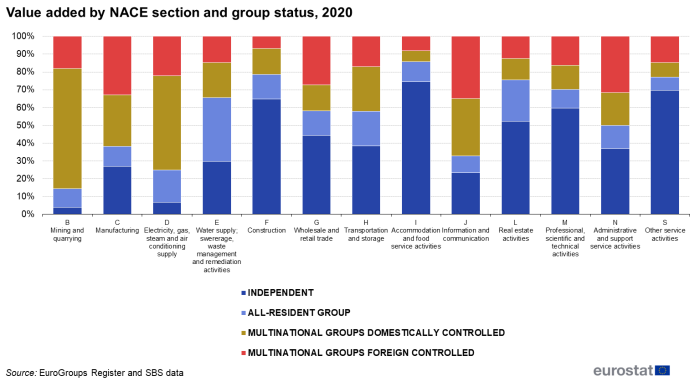
Source: EuroGroups Register and SBS data
Link to Nace Rev.2 classification
Source data for tables and graphs
Data sources
This micro data linking exercise focused on linking the available statistical information from following data sources:
- the Structural business statistics (SBS)
- the National Statistical Business Registers (national BRs)
- the EuroGroups Register (EGR)
The SBS describe the detailed structure, economic activity, and performance of businesses over time. The SBS data collection has a very good coverage in terms of size classes of enterprises and their economic activity. Thus, this source provides the most comprehensive picture of the European economy, both at country and EU level.
The National Statistical Business Registers (national BRs): register of businesses at national level, of which a common core is harmonised pursuant to this Regulation, as a basis for the preparation and coordination of surveys and as a source of information for the statistical analysis of the business population and its demography, for the use of administrative data, and for the identification and construction of statistical units.
The EuroGroups register (EGR) is the source of the multinational enterprise groups data. It produces data in yearly cycles and covers microdata on the MNE groups and their consisting enterprises and legal units. It serves statistical purposes only. Access to EGR data is restricted to national statistical institutes and national central banks that produce official statistics in the EU Member States and EFTA countries. The EGR aims to register all multinational enterprise groups that have enterprises in EU Member States or EFTA countries, including European and non-European MNE groups. EGR does not cover all-resident enterprise groups – those that consist of enterprises only in 1 country, nor independent enterprises.
Context
Globalisation and the increasing complexity of multinational enterprise group activities makes it challenging to record as well as to analyse correctly and consistently the MNE group activities in European statistics. The ultimate goal of this project was to produce new statistical indicators that could improve insight into business performance of enterprises that build a part of an MNE Group, either domestically or foreign-controlled. The method used was the micro data linking (MDL), where the use of unique identification numbers for enterprises in different statistical domains was a key pre-condition for being successful. Microdata linking is increasingly recognised as a powerful tool to provide new statistics without increasing the burden on respondents. For business statistics, business registers are the backbone of most microdata initiatives.
Direct access to
See also
Dedicated section
Methodology
Legislation
- Regulation (EEC) No 696/1993 of 15 March 1993 on the statistical units for the observation and analysis of the production system in the Community (Summary)
- Regulation (EU) 2019/2152 of the European Parliament and of the Council of 27 November 2019 on European business statistics, repealing 10 legal acts in the field of business statistics
- Implementing Regulation (EU) 2020/1197 of 30 July 2020 laying down technical specifications and arrangements pursuant to Regulation (EU) 2019/2152 of the European Parliament and of the Council on European business statistics repealing 10 legal acts in the field of business statistics
